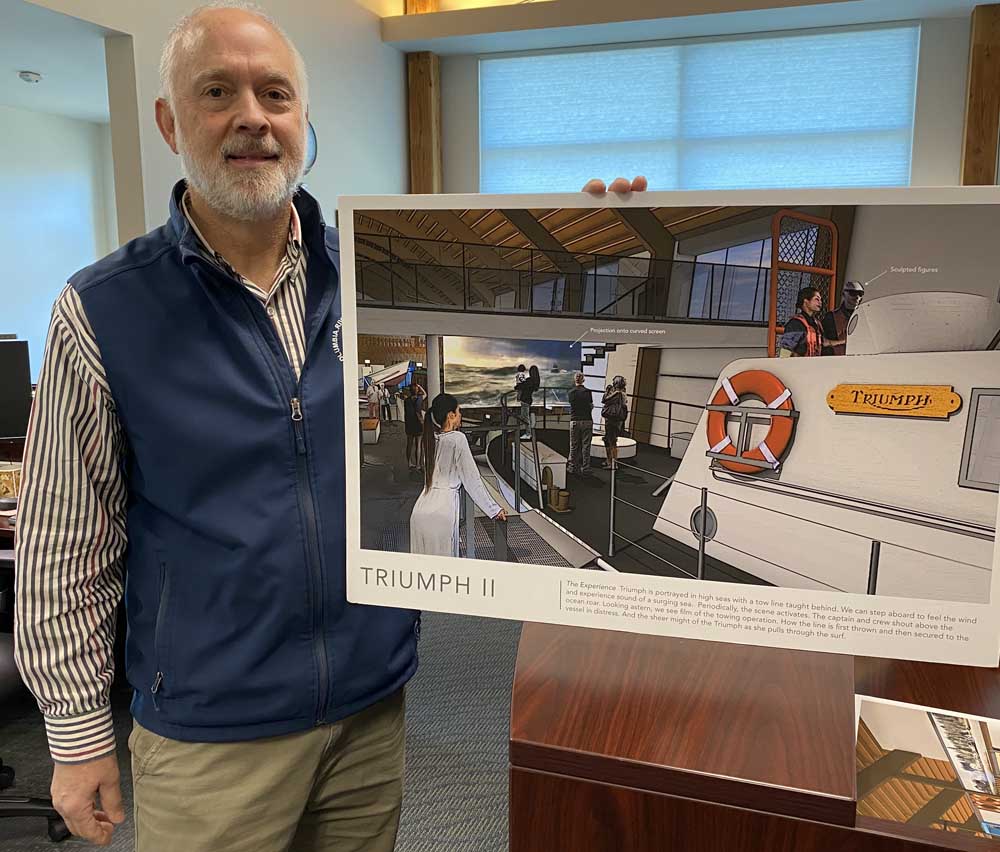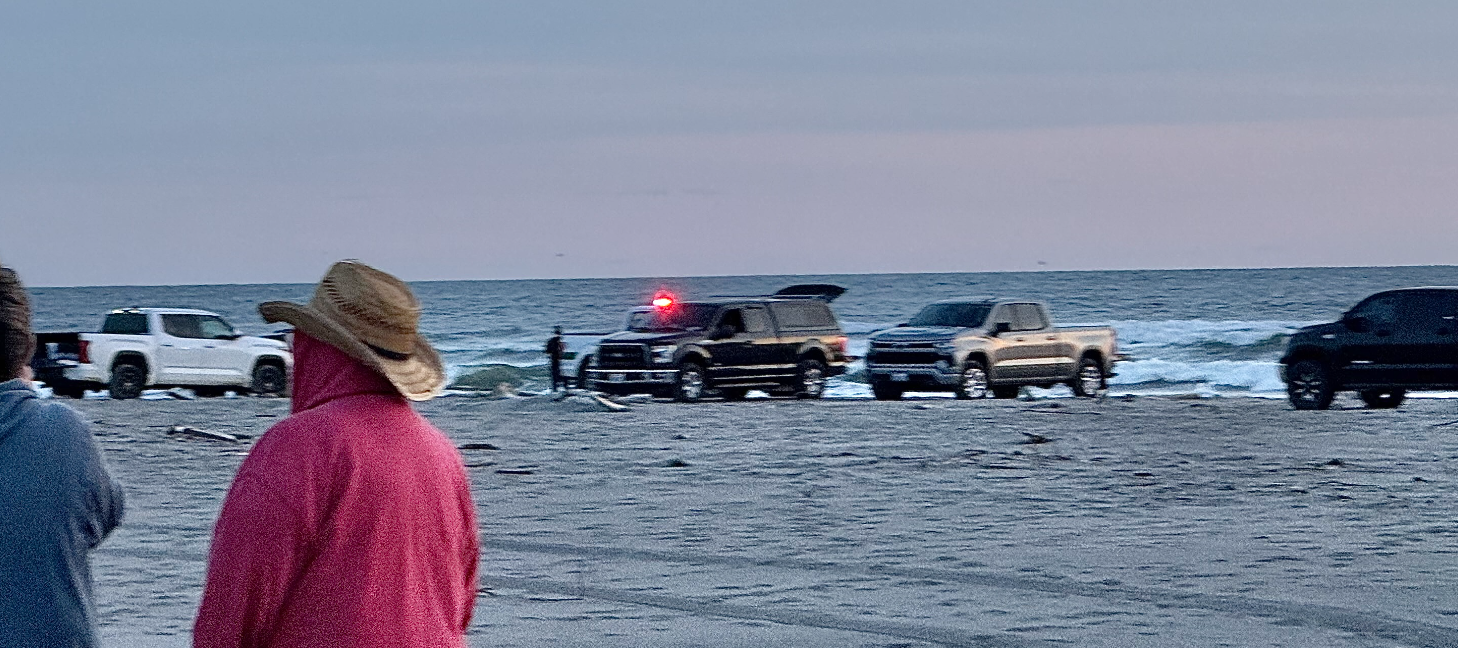Coast Chronicles: The Triumph, a piece of history
Published 2:10 pm Thursday, December 5, 2024

- Bruce Jones, executive director of the Columbia River Maritime Museum, holds a concept drawing of the Triumph display. Visitors will be able to walk onto the deck and explore.
At the Veterans Lunch this year — another triumph of 122 honored vets, good grub and lots of talk story — Coastie Lee LaFollette was one of the greeters at the door. He took me aside and leaned in to say, “I have a story tip for you. There’s a lifeboat being retired by the Coast Guard to the Maritime Museum. Here, talk to Jerry about it.” (Jerry, also a greeter, handed me his card.)
So last week, I dialed up Jerry Ostermiller to get the scoop. He confirmed the story. “Yup, the Coast Guard is retiring a motor lifeboat that’s been in service — well, I don’t know exactly … but it has a long history of life saving on the Columbia bar. Its operators didn’t want to see it go because it’s had such a reputation for strength and power. Those 52-footers are almost like diesel tractors known for pulling boats that are in trouble across the bar. They’ve been discontinued, but they’re famous.”
Jerry knows whereof he speaks. He was the executive director of the Maritime Museum for 20 years and is the person responsible for that pitched up boat featured in the front window of the museum. “That was my last project. And that boat is tipped up in just the way it would actually be on a rescue. The way we displayed it is actually what it would look like going out in the worst conditions, in 25- or 30-foot waves. I’m really proud of that display. It won a national award: I was given a distinguished public service award by the commandant of the Coast Guard in Washington, D.C.”
“I think everyone knows that our Columbia bar is the ‘Graveyard of the Pacific.’ Lloyd’s of London, ship insurers, have called it the most hazardous crossing in the world. It’s so predictably dangerous that’s why the National Motor Lifeboat Training School (NMLBS) is located in Ilwaco. Thousands of people have died on the crossing.”
Columbia River Maritime Museum
Then Jerry introduced me to Jeff Smith, curator of the Columbia River Maritime Museum, who directed me to current executive director, Capt. Bruce Jones. If you haven’t been to the museum for awhile, I suggest you remedy that: there is so much on offer (www.crmm.org). I have to admit I hadn’t been through the door for decades until I stopped by to visit with Bruce last week.
There’s a fabulous gift shop, several rotating exhibit spaces, educational films and programs, a reference library, and amazing artifacts and videos. There is even a part of the hull of the Exxon Valdez, brought back by the Salvage Chief, which was dispatched from Astoria to the oil spill,” said Bruce. “The museum was founded in 1962, and we have one of the largest collections of Pacific Northwest maritime artifacts in the country. And now, ground has broken for the Warnock Mariners Hall Campus that adds 24,500 square feet to the current museum.”
There is one current exhibit that’s especially impressive: — “This Is Our Place — ntsayka ilíi ukuk” — a celebration of the Chinook Nation maritime traditions through the photography of Amiran White (made possible by the Roundhouse Foundation). There’s also an accompanying display of Native culture: weaving, carving, fishing gear and knowledge, and a series of short videos of Native artists — all beautifully conceived.
Our boat!
But I was there to talk about the Triumph, one of the small fleet of 52-foot motor lifesaving vessels that served our coast from 1961 through 2021. Everyone I spoke with who knows this vessel glows with memories about its efficacy, safety and capabilities. “It’s our boat,” as Bruce said. “Three of the other 52-footers worked the harbors of Newport, Coos Bay and Grays Harbor; but the Triumph was our rescue vessel at the mouth of the Columbia.”
I also spoke with Tom Molloy, a Coastie for 23 years, who now trains the trainers and supervises other analytics at the NMLBS. He operated the Triumph for many years. “When you’re on the Triumph you can feel it in the bones of the vessel — all the rescues and the lives saved. You know you’re riding a piece of history. It has the capabilities of a tank but it rides like a Cadillac. You felt safe and you can feel the pride and the beauty of it — all the care and maintenance that went into that boat.”
Tom continued, “I’ve forgotten a lot of the memories over time, but I know that for every rescue we went out on, you could feel the relief when the 52 was on the scene. That’s the boat everyone wanted to see. For a small fishing boat in trouble, you’d send out a 29-footer. For a larger vessel, maybe the 47-footer. But in big surf, you’d want the Triumph. Then there’s a gap up to the Coast Guard Cutter at 225 feet.”
So why, you might ask, was this legend of the seas decommissioned? It seems as though parts availability was the problem. [There’s no doubt another story here but let’s not open that Pandora’s Box of governmental politics.] According to some I spoke with “nothing yet has filled the gap of the 52 footers.”
Lifesaving
Just for a moment, let’s simply send massive kudos to Coast Guard men and women who risk their lives to save others. Bruce told me a harrowing story about his operation of the H60 Jayhawk helicopter 400 miles off the coast of North Carolina — at night in a gale — when they had to convince three people to jump off the sailboat Malachite into huge seas so they could be picked up by one of the Coastie swimmers. (A helicopter can’t hover over a fully rigged sailboat for obvious reasons.) It was a six-hour one-way trip and they had a maximum of 30 minutes to complete the pick-up before low fuel would necessitate a return. It was too far offshore to make it back, so they continued on another 275 miles to Bermuda, the closest point of land. “You’ve got to fight vertigo in a helicopter in those of heavy seas,” said Bruce. (I was green just listening. See a video: www.youtube.com/watch?v=q6DooAco8rc.)
Tom also talked about receiving a SAR alarm — search and rescue — in heavy seas while he was in the Triumph: “A vessel had hit the South Jetty and both props got chewed off. But I was never in doubt about our safety on the Triumph.” For us landlubbers, these life and death situations arrive rarely. But for men and women who work on the water, they can be a daily or weekly occurrence. (Especially as we head into our notoriously lethal winter weather, please send protective thoughts and prayers for our Coasties.)
So back to Columbia River Maritime Museum: The Triumph will be housed in the new wing of the museum, along with the Merrimac yacht, built by Joe Dyer, and one of the George Pocock boats like the one that won the 1936 Olympic gold medal, among others. Bruce is leading this building effort, and his goal is to “create one of the top 15 maritime museums in the world.” That global reach is built on the foundation of honoring all our local sailors, fishermen and women, boat builders and designers, life savers, engineers, cannery workers, and all the families involved in the maritime traditions of our region.
As the holidays approach, why not consider a museum membership or a donation to this building effort? At the very least, stop by soon to take in the current exhibits. This museum is a gem we locals often forget about. Time to put it on your bucket list.





